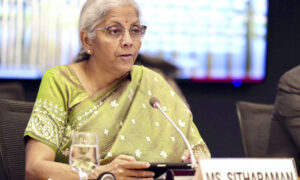
India remains the fastest growing economy in the world – economic fundamentals are strong, and reform momentum continues. GST is on track for implementation in the second quarter of the fiscal year and is expected to yield substantial growth dividends from higher efficiencies and raise more revenues in the long term, according to a new World Bank report released today. While, agriculture growth delivered in 2016-2017, the report notes that investment growth remains subdued, partly because of banking sector stress.
The report also highlights the low and falling participation of women in the labor market. For India to achieve higher growth, it needs to create safe, flexible and well-paying jobs for a large number of women who are currently not in the labor market.
The report says the fundamentals of the Indian economy remain strong, with robust economic growth, strong fiscal consolidation, low current account deficit, higher agricultural output, growing FDI, low inflation and higher wages in rural areas. Favorable monsoons boosted agriculture and rural consumption, while urban consumption remained robust and exports rebounded in the third quarter of 2016-2017.
Timely and smooth implementation of landmark reforms such as the GST and a new code to deal with bankruptcies, as well as decisive action to resolve the NPA challenge of public sector banks, is crucial to enhance the economy’s potential growth, says the May 2017 edition of the Indian Development Update.
The report notes that India will achieve a major reform of indirect taxes through the GST without increasing the burden on the poor. Given the efficiency and revenue gains that the reform will eventually achieve, the overall impact of the GST on equity and poverty is likely to be positive.
“India remains the fastest growing economy in the world and it will get a big boost from its approach to GST which will – reduce the cost of doing business for firms, reduce logistics costs of moving goods across states, while ensuring no loss in equity,” said Junaid Ahmad,World Bank Country Director in India. “Low female labor force participation, however, remains a serious concern. A Higher level of women participation in the economy can help propel India closer to double digit growth”.
Demonetization has potential to bring positive transformation
India’s economy was slowing down in early FY17, until the favorable monsoon started lifting the economy, but the recovery was temporarily disrupted by the government’s “demonetization” initiative. On November 8, 2016, the government demonetized (i.e. removed legal tender status from) an estimated 23 billion INR 500 and INR1000 banknotes, corresponding to 86 percent of India’s currency in circulation. Demonetization caused an immediate cash crunch, and activity in cash reliant sectors was affected. GDP growth slowed to 7.0 per cent year-on-year (y/y) during the third quarter of 2016-2017 from 7.3 percent in the first quarter.
As a result, a modest slowdown is expected in the GDP growth in FY 2016-2017 to 6.8 percent. According to the Update, growth is expected to recover in FY 2017-2018 to 7.2 percent and is projected to gradually increase to 7.7 percent in FY 2019-2020.
While limited data is available, demonetization may have had a disproportionate impact on poorer households, which are more likely to work in construction and informal retail. Demand for guaranteed employment up to February 2017 exceeded the full year of FY2015/2016 and rural consumption (in particular, sales of two-wheelers) contracted sharply in November. Greater data availability, especially on labor markets, is needed to better gauge the social impact of policies in the future.
Despite this, there was a relatively modest slowdown in the economy. The Update attributes it to coping mechanisms (which included greater usage of digital transactions), higher rural incomes, and robust public consumption. The pick-up in rural wages in November and December and the growth of agricultural output suggests the positive impact of the monsoons substantially dampened the disruption from demonetization.
In the long-term, demonetization has the potential to accelerate the formalization of the economy, leading to higher tax collections, and greater digital financial inclusion provided measures such as increased use of property taxes is taken in the areas of tax policy and administration, and share of the population with access to the internet and digital means of payments are increased. The implementation of the GST could is a key complementary reform that will support formalization, as firms have a strong incentive to register with GST to obtain input tax credits, the Update adds.
The monsoon delivered, but investment growth remains subdued
The Update acknowledges that agricultural growth has had the most positive impact on the Indian economy in FY17. Agriculture growth jumped to 6.0 percent in the third quarter of FY2017 from 3.8 percent in the second quarter. This was the highest growth in nearly five years. The second advance estimate of production puts cereal output for FY2017 at nearly 250 million tons, crossing the previous record of about 246 million tons harvested in 2013-14. The Update is also optimistic that growth in private investments is likely to pick up once there is greater certainty on the global outlook, as well as when implementation of the GST is more advanced.
“Private investment growth continues to face several impediments in the form of excess capacity, regulatory and policy challenges, and corporate debt overhang. However, the recent push to increase infrastructure spending and to accelerate structural reforms will eventually drive a sustained rebound of private investments,” said Frederico Gil Sander, Senior Country Economist and the main author of the India Development Update.
However, credit growth, particularly to industry remains weak. Although credit data for November and December are clouded by banks’ focus on exchanging old notes rather than lending, credit growth even in January and February of this year was about 3.5 percent (y/y). Banks have used higher deposits post-demonetization to buy government securities rather than to expand credit. This suggests weak credit demand, as many large corporates remain highly leveraged and global capacity in key sectors such as steel is ample, the Update says.
Unlocking the potential of Indian women
A special focus of this report has been on the low female labor force participation of women in India. India has one of the lowest female participation rates in the world, ranking 120th among the 131 countries for which data are available. Even among countries with similar income levels, India is at the bottom, together with Yemen, Pakistan and Egypt. Worse still, the rate has been declining since 2005. This is a matter of concern as women’s paid employment is known to increase their ability to influence decision-making within the household, and empower them more broadly in society as a whole, the Update says.
In fact, less than a third or only 27 percent of women 15 years or older are working or actively looking for a job. Three of every five prime working age Indian women (26-45 years) are not economically active, meaning that they are neither working on a farm or in businesses nor are they earning any wage.
“This is a cause for concern since higher labor earnings are the primary driver of poverty reduction. It is often argued that declining female participation is due to rising incomes that allow more women to stay at home. The evidence, however, shows that fewer jobs in agriculture have not been replaced by alternative jobs considered suitable for women,” Ahmad added.
In fact, at 42 per cent, India has some of the highest share of graduates in science and technology among the comparator countries like Indonesia or Brazil, but only 34 percent of women with a post-secondary degree are in the labor market.
“India’s female labor force participation rate is uniquely low for all levels of education. Sixty five percent of Indian women with college degrees are not working whereas in Bangladesh 41 percent and in Indonesia and Brazil only 25 percent of women graduates are not working,” Sander added.
India has only created jobs equivalent to 0.9 percent of the adult population between 2005 and 2012 and most of these regular wage jobs created went to men. Also, in Bangladesh 33 percent of its labor force working in industry are women whereas in India it’s only about 17 percent, the Update says. This reflects the importance of the government’s recent package for the labor intensive garment and textile industry, which tends to create jobs for women.
According to an assessment done by the World Bank, India’s potential GDP growth can go up by a full percentage point if half the gap in female labor force participation rate with Bangladesh or Indonesia, is closed.
The key to close the gender gap is to create more jobs, especially regular salaried jobs that are flexible and can be safely accessed by women, the Update con


















